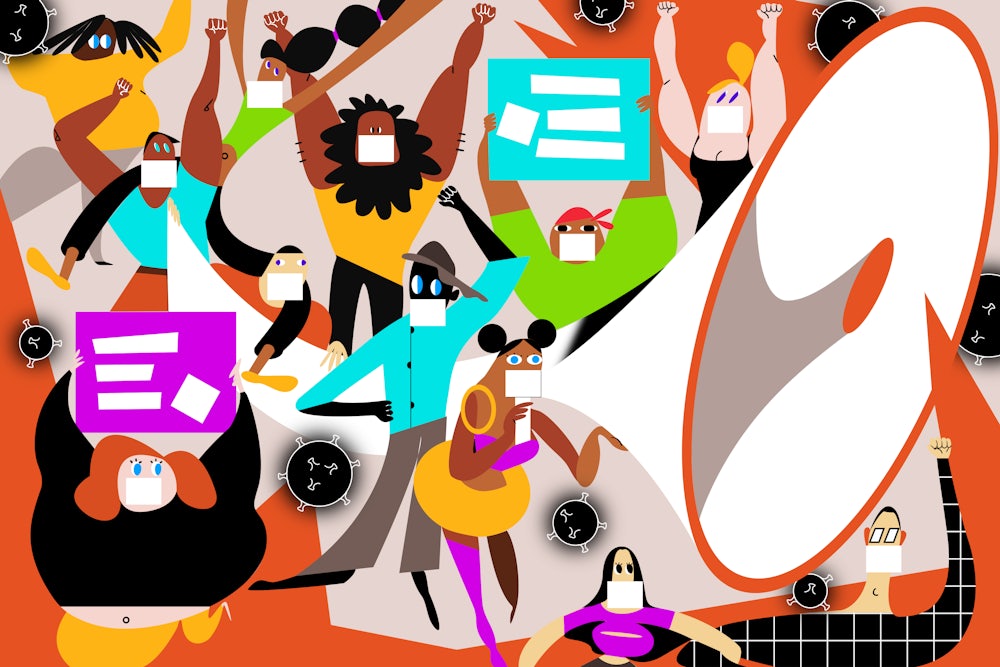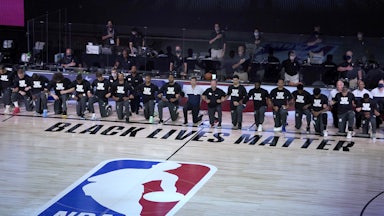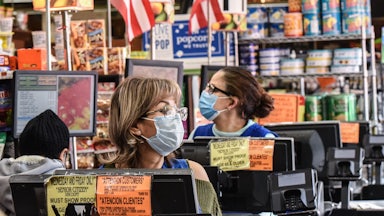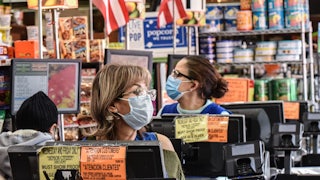Energy was high, and the night air was cold, so people were dancing. The music switched between Anuel AA and Pop Smoke, while Teamsters wearing thick layers—hats, gloves, masks—chanted in call and response. “Just got one question for you: What do you want?” one of the workers at the mic asked. “Yo, what do you want?”
I thought someone said, “Bad Bunny,” but it was: More money.
In the first major work stoppage of 2021, more than 1,400 warehouse workers and drivers represented by Teamsters Local 202 are on strike at the Hunts Point Produce Market in the Bronx. The strike, now entering its fifth day, is a response to a stalemate in negotiations with the owners of the Hunts Point Produce Market—which takes in more than $2 billion in annual revenue, according to the New York City Economic Development Corporation—over a $1 wage increase and an additional 60 cents in health benefits.
The Hunts Point workers are the very definition of essential: The market, a cooperative of 30 merchants, supplies 60 percent of New York City’s produce, with workers handling and unloading the more than 210 million pounds of fresh fruits and vegetables that pass through the market yearly. These are the workers who keep their city fed.
William Parker, 56, has worked at the market for eight years. “We are here for a wage increase and better health care,” Parker told me. “When my wife needs to go to the hospital, I have to pay out of pocket. That shouldn’t be. We need more.… We are out here working overnight while the city sleeps. We are making sure that you have stuff to put on your table in the morning.”
We are nearly a year into a pandemic that has killed close to half a million people, with a chaotic and inadequate vaccine rollout that has so far extended the horizon of that lethality. Workers in “essential” industries, from critical infrastructure workers like the Hunts Point drivers and warehouse staff to those in education and health care, have been forced to bear the heaviest burdens of this failed political response. “When going to work every day is touted as an act of heroism … workers are reminded of what they are risking,” as Sarah Jaffe wrote back in May, when the Covid-19 death toll first approached 100,000. “In this moment, the coercive nature of that work is more obvious—and the fact that we do not have any right to demand people do it is becoming more clear.” Combine that dynamic with the number of union contracts expiring this year, and you can begin to see the potential for a new wave of worker militancy. “Time will tell,” Daniel Kane Jr., president of Teamsters Local 202, told me, sounding circumspect.
The language of a strike wave is the language of radical optimism in the face of untenable conditions. As the workers on the picket that night knew, there’s no guarantee, only opportunity. Union density in this country continues to dwindle, hovering around just 10 percent. One-off declarations about general strikes ring empty. But ground-level organizing and a national push to make it easier to form and keep a union point to a stronger future. The seeds to grow militancy are there.
The coming labor battles in 2021 will include “450 collective bargaining agreements, involving more than a million and a half workers,” as Rand Wilson and Peter Olney wrote recently in Labor Notes. Like the Teamsters on strike in the Bronx, many of these workers—among them 200,000 health care workers, 161,000 municipal workers, 112,000 state workers, and 100,000 school employees—have long been essential but are even more so now that they’re on the front lines of the pandemic. Those conditions have been clarifying.
In November of last year, the contradiction between the importance of their work and the conditions of their labor helped sustain a two-day strike at an industrial laundry plant in New Jersey, where workers are responsible for disinfecting patient bedsheets, gowns, and other linens for the largest municipal health care system in the country. “The structure for how health care is provided, fueled by exorbitant profits, is going to make the worker begin to feel that they are just a cog in a machine and expendable,” Professor Robert Anthony Bruno, director of the Labor Education Program at the University of Illinois at Urbana-Champaign, said at the time. “That’s definitely going to fuel militancy.”
Early in the pandemic, workers at Whole Foods engaged in a sickout as a means to demand safer working conditions, better wages, and increased access to personal protective equipment. These were early, tenuous actions, but the conditions that fueled them haven’t gone anywhere. On Wednesday, four days into the Teamsters strike, the Chicago Teachers Union’s House of Delegates—the governing body for the union representing more than 28,000 teachers, paraprofessionals, clinicians, and support staff—voted on a strike authorization, with 48 hours for rank-and-file members to approve the measure. Earlier this month, a federal judge blocked the strike threat—issued in December over a lack of Covid protections—of one of the main unions of the Omaha-based railroad company Union Pacific. “If you have the encouragement, and tools to get together with more and more co-workers to say, ‘Fuck you, we are not cogs,’ there you will find new organizing, more collective action, and more strikes,” Patrick Burke, an organizer with United Auto Workers Local 2322 in Massachusetts, told me.
But where that militancy builds, the forces of capital are there to meet it. On Martin Luther King Jr. Day, cops in riot gear broke the Teamsters’ picket line, arresting six members. In a video posted by Teamsters Joint Council 16, strikers raise their hands and shout: “Hands up, don’t shoot.” In another video, a police recording booms, Robocop-meets-Alexa-style: “You are ordered to leave the roadway and use the available sidewalk. If you do so voluntarily, no charges will be placed against you.” (The six strikers were issued summonses for disorderly conduct and were subsequently released.)
“It is outrageous that after being called essential heroes for months, several of our members were arrested while peacefully protesting for a raise today,” Kane said in a statement. “These are the essential workers who went to work every day through the worst of the pandemic to feed New York. All they are asking for is a dollar-an-hour raise so they can feed their families, too. The fact that they were arrested on Martin Luther King Day reminds us what side of history we are on.”
The workers of Local 202 earn between $18 and $21 an hour, which comes out to a base annual salary of $40,000. According to MIT’s Living Wage calculator, a crude but useful metric of what it takes to get by in a given place, a living wage for a parent raising one kid in New York City is just over $32. For two kids, it’s $42.
The Covid crisis has only worsened the economic strain workers face—with many people supporting loved ones who have lost work and income in the pandemic recession. At the height of the pandemic last year, Bronx residents were twice as likely to die from the virus, and, with the highest unemployment rate in the city, nearly a quarter of residents were out of work in June. With a new, more highly contagious variant taking hold in the city, and a vaccine rollout that has left essential workers and other eligible residents with canceled appointments or long delays, we are looking at another long winter.
In anticipation of the strike, the Hunts Point Produce Market Cooperative issued a statement on the stalled negotiations. “We are very proud to have kept our union workers—the vast majority of whom live right here in the Bronx—working and on payroll with full health benefits as the Bronx has seen an unemployment rate of 40 percent,” it read, with “workers’ wage and benefit increases over the next three years that are a multiple of the current annual cost of living.”
The Teamsters on strike and the people standing on the picket with them say that’s not enough. “There’s a lot of things upside down right now in our economy. One of those things upside down is … that a person who is helping get the food to your table cannot feed their own. That’s upside down,” said Representative Alexandria Ocasio-Cortez, who showed up to the picket on Wednesday night with coffee and hot chocolate. “What we are doing here today is taking the upside down and making it right-side up,” she continued. “And the only way we do that … we don’t do that with just a politician like myself. We do that with people and collective struggle together.”
That same night, 21 train cars of merchandise pulled into the Hunts Point Market. Then, seeing the strike, according to a Local 22 worker, “the locomotive engineer said, ‘We’re Teamsters too.’” They wouldn’t cross the picket.
These are the moments when you can picture it—the wave: When union bus drivers in New York City refused to transport protesters arrested by the NYPD during the uprisings of the summer, when NBA players walked off the court in solidarity with protests against racist police violence. But they’re only glimpses. In 2019, there were only 25 work stoppages involving 1,000 workers or more. The following year, there were only 10, according to Jacobin’s Alex N. Press. In 1970 alone, as Robin Kaiser-Schatzlein recently noted at The Baffler, “there were 5,716 strikes involving more than 3 million workers, many of which were self-organized, sometimes illegal, wildcat strikes.”
These are different times. There is a long way to go. But the mood in the air some nights can feel electric. “We are not gonna bend, not gonna fold, not gonna give in,” Parker, the striking Teamster, told me as people danced, chanted, and did their best to stay warm. “We are fighting so that we can all live. All we want to do is live; we want to survive; we want to provide for our families.”








